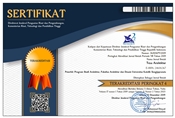Studi Komparasi Seting Tempat Aktivitas di Lingkungan Perumahan Kawasan Perdesaan Pegunungan
Abstract
Keywords
Full Text:
PDFReferences
Aderina L, Syahadat R.R, Putra P.T. 2018. Perilaku Pengguna Ruang Publik di Kompleks Militer Batalyon Artileri Medan 10 Bogor, Jurnal Tesa Arsitektur, Vol.16. No.1, Hal. 1-10.
Aditama M.S, 2013. Faktor Penentu Seting Fisik dalam Beraktifitas di Ruang Terbuka Publik : Studi Kasus Alun-alun Merdeka Kota Malang, Jurnal Ruas, Vol. 11, No, 2, Hal. 1-9.
Groat L, and Wang D. 2002. Architectural Research Methode. Jhon Willey & Son, Inc., New York.
Howel K.E. (2013).An Introduction to The Philosophy of Methodology, Sage, Los Angeles.
Nuraini C. 2004. Permukiman Suku Batak Mandailing, Gadjah Mada University Press, Yogyakarta, Hal. 118-121.
Nuraini C, Djunaedi A, Sudaryono dan Subroto YW. 2014a.Bincar-Bonom as the Basis of house Formations in Singengu Village Settlement. Journal of Scientific Research and Studies, Vol.1 (6), December 2014, ISSN 2375-8791,http://www.modernrespub.org/jsrsjindex.htm, pp.118-130.
Nuraini C, Djunaedi A, Sudaryono and Subroto YW. 2014b.Bincar-Bonom : The Basis of Spatial Arrangements of Singengu Village, Indonesia. Journal of the International Society for the Study of Vernacular Settlements (ISVS e-Journal) Vol.3, No.2, December 2014, Publised on 2015, pp. 1-16.
Nuraini C. 2015. Posisi Teori Bincar-Bonom dalam Konsep Dasar Elemen-elemen Pembentuk Permukiman, Studi Kasus Desa Singengu di Kecamatan Kotanopan. Jurnal Nalars, Volume 14 Nomor 2, Juli 2015. ISSN 1412-3266. Hal.97-100.
Nuraini C. 2016. Pengembangan Teori Place Attachment Berbasis Bincar-
Bonom pada Lingkungan Prumahan Desa Singengu di Mandailing Julu, Sumatera Utara, Fakultas Teknik, Universitas Pembangunan Panca Budi, Jurnal ArchiGreen, Vol. 3. No. 4, Hal. 1-10.
Nuraini C. 2017. Room Arrangement Concept : The Sacred-Profand of Heirloom Houses in Hutagodang Village, Mandailing. Architecture Departemen, Faculty of Civil Engineering and Planning, Trisakti University, Journal LivaS : International journal on Livable Space, Vol.02, No. 2, pp. 45-54.
Nuraini C. 2018. The Logic of Bincar-Bonom and Structuralism Analysis on Room Arrangement of Dwelling in Mandailing, DIMENSI–Journal of Architecture and Built Environment, Vol. 45, No. 1, pp. 85-92.
Nurhamsyah M, 2016. Tipe Seting Teritori Teras Akibat Aktivitas Tambahan Penghuni di Permukiman Pesisir Sungai Kapuas, Jurnal Langkau Betang, Vol. 3, No. 1. Hal. 43-56.
Santoso J.T, Mustikawati T, Suryasari N. 2016. Pola Aktivitas Wisata Belanja di Kampung Wisata Keramik Dinoyo, Malang. Jurnal Tesa Arsitektur, Vol. 14, No. 1, Hal. 1-9.
Sunaryo R.G, 2010. Perubahan Seting Ruang dan Pola Aktivitas Publik di Ruang Terbuka Kampus UGM. Proseding Seminar Nasional Riset Arsitektur dan Perencanaan (SERAP-1) : Humanisme, Arsitektur dan Perencanaan, Fakultas Teknik, Program Studi Teknik Arsitektur dan Perencanaan dan Program Doktor, Universitas Gadjah Mada (UGM), Yogyakarta. Hal. 175-181
Wasilah dan Hidayati A, 2016. Kajian Pemanfaatan Ruang Kawasan Permukimab Tepian Kanal Pampang Kota Makassar berdasarkan Aktivitas Sosial Masyarakat. Proseding temu Ilmiah IPLBI 2016, hal. 51-54.
Yin R.K. 2003. Studi Kasus : Desain dan Metode. PT. Raja Grafindo Perkasa, Jakarta.
Zahnd M, 1999. Perancangan Kota Secara Terpadu. Penerbit Kanisius. Yogyakarta.
DOI: https://doi.org/10.24167/tesa.v18i2.2231
ISSN 1410-6094 (Print) | ISSN 2460-6367 (Media Online) | View My Stats

This work is licensed under a Creative Commons Attribution 4.0 International License.








